11.4: The Cross Product
( \newcommand{\kernel}{\mathrm{null}\,}\)
- Calculate the cross product of two given vectors.
- Use determinants to calculate a cross product.
- Find a vector orthogonal to two given vectors.
- Determine areas and volumes by using the cross product.
- Calculate the torque of a given force and position vector.
Imagine a mechanic turning a wrench to tighten a bolt. The mechanic applies a force at the end of the wrench. This creates rotation, or torque, which tightens the bolt. We can use vectors to represent the force applied by the mechanic, and the distance (radius) from the bolt to the end of the wrench. Then, we can represent torque by a vector oriented along the axis of rotation. Note that the torque vector is orthogonal to both the force vector and the radius vector.
In this section, we develop an operation called the cross product, which allows us to find a vector orthogonal to two given vectors. Calculating torque is an important application of cross products, and we examine torque in more detail later in the section.
The Cross Product and Its Properties
The dot product is a multiplication of two vectors that results in a scalar. In this section, we introduce a product of two vectors that generates a third vector orthogonal to the first two. Consider how we might find such a vector. Let ⇀u=⟨u1,u2,u3⟩ and ⇀v=⟨v1,v2,v3⟩ be nonzero vectors. We want to find a vector ⇀w=⟨w1,w2,w3⟩ orthogonal to both ⇀u and ⇀v—that is, we want to find ⇀w such that ⇀u⋅⇀w=0 and ⇀v⋅⇀w=0. Therefore, w1, w2, and w3 must satisfy
u1w1+u2w2+u3w3=0
v1w1+v2w2+v3w3=0.
If we multiply the top equation by v3 and the bottom equation by u3 and subtract, we can eliminate the variable w3, which gives
(u1v3−v1u3)w1+(u2v3−v2u3)w2=0.
If we select
w1=u2v3−u3v2w2=−(u1v3−u3v1),
we get a possible solution vector. Substituting these values back into the original equations (Equations ??? and ???) gives
w3=u1v2−u2v1.
That is, vector
⇀w=⟨u2v3−u3v2,−(u1v3−u3v1),u1v2−u2v1⟩
is orthogonal to both ⇀u and ⇀v, which leads us to define the following operation, called the cross product.
Let ⇀u=⟨u1,u2,u3⟩ and ⇀v=⟨v1,v2,v3⟩. Then, the cross product ⇀u×⇀v is vector
⇀u×⇀v=(u2v3−u3v2)ˆi−(u1v3−u3v1)ˆj+(u1v2−u2v1)ˆk=⟨u2v3−u3v2,−(u1v3−u3v1),u1v2−u2v1⟩.
From the way we have developed ⇀u×⇀v, it should be clear that the cross product is orthogonal to both ⇀u and ⇀v. However, it never hurts to check. To show that ⇀u×⇀v is orthogonal to ⇀u, we calculate the dot product of ⇀u and ⇀u×⇀v.
⇀u⋅(⇀u×⇀v)=⟨u1,u2,u3⟩⋅⟨u2v3−u3v2,−u1v3+u3v1,u1v2−u2v1⟩=u1(u2v3−u3v2)+u2(−u1v3+u3v1)+u3(u1v2−u2v1)=u1u2v3−u1u3v2−u1u2v3+u2u3v1+u1u3v2−u2u3v1=(u1u2v3−u1u2v3)+(−u1u3v2+u1u3v2)+(u2u3v1−u2u3v1)=0
In a similar manner, we can show that the cross product is also orthogonal to ⇀v.
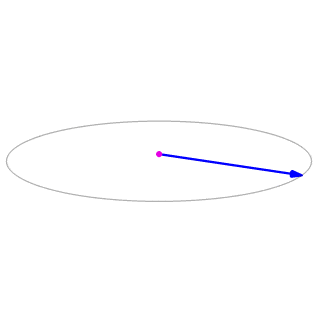
Let ⇀p=⟨−1,2,5⟩ and ⇀q=⟨4,0,−3⟩ (Figure 11.4.1). Find ⇀p×⇀q.
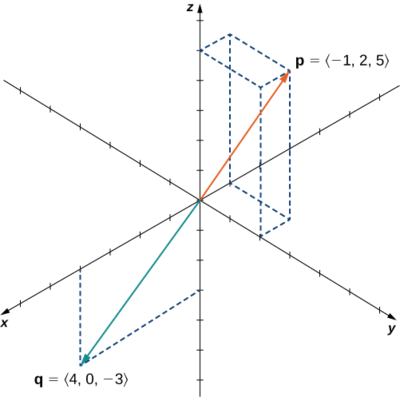
Solution
Substitute the components of the vectors into Equation 11.4.7:
⇀p×⇀q=⟨−1,2,5⟩×⟨4,0,−3⟩=⟨p2q3−p3q2,−(p1q3−p3q1),p1q2−p2q1⟩=⟨2(−3)−5(0),−(−1)(−3)+5(4),(−1)(0)−2(4)⟩=⟨−6,17,−8⟩.
Find ⇀p×⇀q for ⇀p=⟨5,1,2⟩ and ⇀q=⟨−2,0,1⟩. Express the answer using standard unit vectors.
- Hint
-
Use the formula ⇀u×⇀v=(u2v3−u3v2)ˆi−(u1v3−u3v1)ˆj+(u1v2−u2v1)ˆk.
- Answer
-
⇀p×⇀q=ˆi−9ˆj+2ˆk
Although it may not be obvious from Equation 11.4.7, the direction of ⇀u×⇀v is given by the right-hand rule. If we hold the right hand out with the fingers pointing in the direction of ⇀u, then curl the fingers toward vector ⇀v, the thumb points in the direction of the cross product, as shown in Figure 11.4.2.
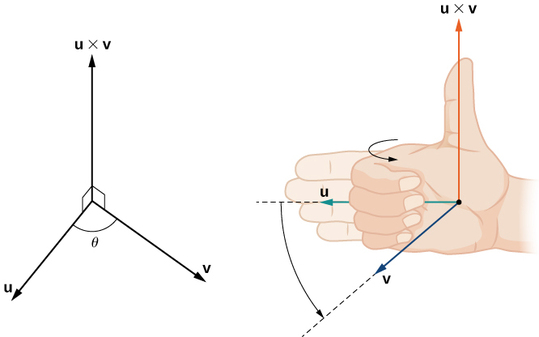
Notice what this means for the direction of ⇀v×⇀u. If we apply the right-hand rule to ⇀v×⇀u, we start with our fingers pointed in the direction of ⇀v, then curl our fingers toward the vector ⇀u. In this case, the thumb points in the opposite direction of ⇀u×⇀v. (Try it!)
Let ⇀u=⟨0,2,1⟩ and ⇀v=⟨3,−1,0⟩. Calculate ⇀u×⇀v and ⇀v×⇀u and graph them.
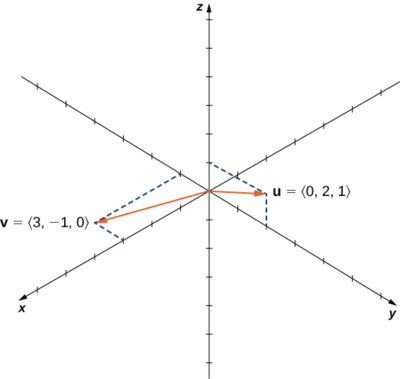
Solution
We have
⇀u×⇀v=⟨(0+1),−(0−3),(0−6)⟩=⟨1,3,−6⟩
⇀v×⇀u=⟨(−1−0),−(3−0),(6−0)⟩=⟨−1,−3,6⟩.
We see that, in this case, ⇀u×⇀v=−(⇀v×⇀u) (Figure 11.4.4). We prove this in general later in this section.
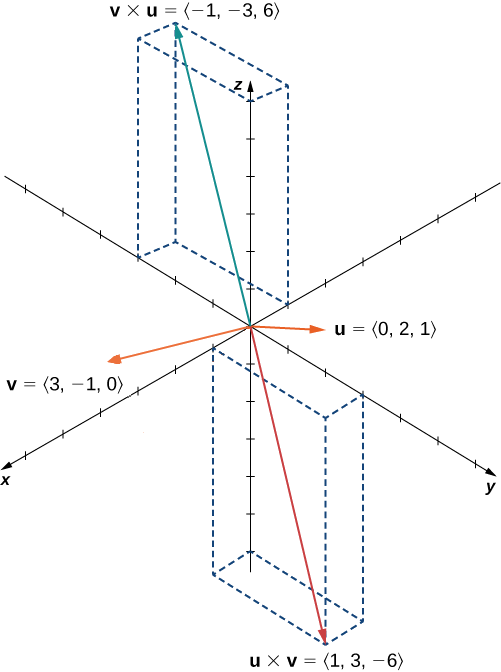
Figure 11.4.4: The cross products ⇀u×⇀v and ⇀v×⇀u are both orthogonal to ⇀u and ⇀v, but in opposite directions.
Suppose vectors ⇀u and ⇀v lie in the xy-plane (the z-component of each vector is zero). Now suppose the x- and y-components of ⇀u and the y-component of ⇀v are all positive, whereas the x-component of ⇀v is negative. Assuming the coordinate axes are oriented in the usual positions, in which direction does ⇀u×⇀v point?
- Hint
-
Remember the right-hand rule (Figure 11.4.2).
- Answer
-
Up (the positive z-direction)
The cross products of the standard unit vectors ˆi, ˆj, and ˆk can be useful for simplifying some calculations, so let’s consider these cross products. A straightforward application of the definition shows that
ˆi׈i=ˆj׈j=ˆk׈k=⇀0.
(The cross product of two vectors is a vector, so each of these products results in the zero vector, not the scalar 0.) It’s up to you to verify the calculations on your own.
Furthermore, because the cross product of two vectors is orthogonal to each of these vectors, we know that the cross product of ˆi and ˆj is parallel to ˆk. Similarly, the vector product of ˆi and ˆk is parallel to ˆj, and the vector product of ˆj and ˆk is parallel to ˆi.
We can use the right-hand rule to determine the direction of each product. Then we have
ˆi׈j=ˆkˆj׈i=−ˆkˆj׈k=ˆiˆk׈j=−ˆiˆk׈i=ˆjˆi׈k=−ˆj.
These formulas come in handy later.
Find ˆi×(ˆj׈k).
Solution
We know that ˆj׈k=ˆi. Therefore, ˆi×(ˆj׈k)=ˆi׈i=⇀0.
Find (ˆi׈j)×(ˆk׈i).
- Hint
-
Remember the right-hand rule (Figure 11.4.2).
- Answer
-
−ˆi
As we have seen, the dot product is often called the scalar product because it results in a scalar. The cross product results in a vector, so it is sometimes called the vector product. These operations are both versions of vector multiplication, but they have very different properties and applications. Let’s explore some properties of the cross product. We prove only a few of them. Proofs of the other properties are left as exercises.
Let ⇀u,⇀v, and ⇀w be vectors in space, and let c be a scalar.
- Anticommutative property: ⇀u×⇀v=−(⇀v×⇀u)
- Distributive property: ⇀u×(⇀v+⇀w)=⇀u×⇀v+⇀u×⇀w
- Multiplication by a constant: c(⇀u×⇀v)=(c⇀u)×⇀v=⇀u×(c⇀v)
- Cross product of the zero vector: ⇀u×⇀0=⇀0×⇀u=⇀0
- Cross product of a vector with itself: ⇀v×⇀v=⇀0
- Triple scalar product: ⇀u⋅(⇀v×⇀w)=(⇀u×⇀v)⋅⇀w
- Triple cross product: ⇀u×(⇀v×⇀w)=(⇀u⋅⇀w)⇀v−(⇀u⋅⇀v)⇀w
For property i, we want to show ⇀u×⇀v=−(⇀v×⇀u). We have
⇀u×⇀v=⟨u1,u2,u3⟩×⟨v1,v2,v3⟩=⟨u2v3−u3v2,−u1v3+u3v1,u1v2−u2v1⟩=−⟨u3v2−u2v3,−u3v1+u1v3,u2v1−u1v2⟩=−⟨v1,v2,v3⟩×⟨u1,u2,u3⟩=−(⇀v×⇀u).
Unlike most operations we’ve seen, the cross product is not commutative. This makes sense if we think about the right-hand rule.
For property iv., this follows directly from the definition of the cross product. We have
⇀u×⇀0=⟨u2(0)−u3(0),−(u1(0)−u3(0)),u1(0)−u2(0)⟩=⟨0,0,0⟩=⇀0.
Then, by property i., ⇀0×⇀u=⇀0 as well. Remember that the dot product of a vector and the zero vector is the scalar 0, whereas the cross product of a vector with the zero vector is the vector ⇀0.
Property vi. looks like the associative property, but note the change in operations:
⇀u⋅(⇀v×⇀w)=u⋅⟨v2w3−v3w2,−v1w3+v3w1,v1w2−v2w1⟩=u1(v2w3−v3w2)+u2(−v1w3+v3w1)+u3(v1w2−v2w1)=u1v2w3−u1v3w2−u2v1w3+u2v3w1+u3v1w2−u3v2w1=(u2v3−u3v2)w1+(u3v1−u1v3)w2+(u1v2−u2v1)w3=⟨u2v3−u3v2,u3v1−u1v3,u1v2−u2v1⟩⋅⟨w1,w2,w3⟩=(⇀u×⇀v)⋅⇀w.
◻
Use the cross product properties to calculate (2\mathbf{\hat i}×3\mathbf{\hat j})×\mathbf{\hat j}.
Solution
\begin{align*} (2\mathbf{\hat i}×3 \mathbf{\hat j})×\mathbf{\hat j} &=2(\mathbf{\hat i}×3\mathbf{\hat j})×\mathbf{\hat j} \\[4pt] &=2(3)(\mathbf{\hat i}×\mathbf{\hat j})×\mathbf{\hat j} \\[4pt] &=(6\mathbf{\hat k})×\mathbf{\hat j} \\[4pt] &=6(\mathbf{\hat k}×\mathbf{\hat j}) \\[4pt] &=6(−\mathbf{\hat i})=−6\mathbf{\hat i}. \end{align*}
Use the properties of the cross product to calculate (\mathbf{\hat i}×\mathbf{\hat k})×(\mathbf{\hat k}×\mathbf{\hat j}).
- Hint
-
\vecs u×\vecs v=−(\vecs v×\vecs u)
- Answer
-
−\mathbf{\hat k}
So far in this section, we have been concerned with the direction of the vector \vecs u×\vecs v, but we have not discussed its magnitude. It turns out there is a simple expression for the magnitude of \vecs u×\vecs v involving the magnitudes of \vecs u and \vecs v, and the sine of the angle between them.
Let \vecs u and \vecs v be vectors, and let θ be the angle between them. Then, ‖\vecs u×\vecs v‖=‖\vecs u‖⋅‖\vecs v‖⋅\sin θ.
Let \vecs u=⟨u_1,u_2,u_3⟩ and \vecs v=⟨v_1,v_2,v_3⟩ be vectors, and let θ denote the angle between them. Then
\begin{align*} ‖\vecs u×\vecs v‖^2 &=(u_2v_3−u_3v_2)^2+(u_3v_1−u_1v_3)^2+(u_1v_2−u_2v_1)^2 \\[4pt] &=u^2_2v^2_3−2u_2u_3v_2v_3+u^2_3v^2_2+u^2_3v^2_1−2u_1u_3v_1v_3+u^2_1v^2_3+u^2_1v^2_2−2u_1u_2v_1v_2+u^2_2v^2_1 \\[4pt] &=u^2_1v^2_1+u^2_1v^2_2+u^2_1v^2_3+u^2_2v^2_1+u^2_2v^2_2+u^2_2v^2_3+u^2_3v^2_1+u^2_3v^2_2+u^2_3v^2_3−(u^2_1v^2_1+u^2_2v^2_2+u^2_3v^2_3+2u_1u_2v_1v_2+2u_1u_3v_1v_3+2u_2u_3v_2v_3) \\[4pt] &=(u^2_1+u^2_2+u^2_3)(v^2_1+v^2_2+v^2_3)−(u_1v_1+u_2v_2+u_3v_3)^2 \\[4pt] &=‖\vecs u‖^2‖\vecs v‖^2−(\vecs u⋅\vecs v)^2 \\[4pt] &=‖\vecs u‖^2‖\vecs v‖^2−‖\vecs u‖^2‖\vecs v‖^2 \cos^2θ \\[4pt] &=‖\vecs u‖^2‖\vecs v‖^2(1−\cos^2θ) \\[4pt] &=‖\vecs u‖^2‖\vecs v‖^2(\sin^2θ). \end{align*} \nonumber
Taking square roots and noting that \sqrt{\sin^2θ}=\sinθ for 0≤θ≤180°, we have the desired result:
‖\vecs u×\vecs v‖=‖\vecs u‖‖\vecs v‖ \sin θ. \nonumber
□
This definition of the cross product allows us to visualize or interpret the product geometrically. It is clear, for example, that the cross product is defined only for vectors in three dimensions, not for vectors in two dimensions. In two dimensions, it is impossible to generate a vector simultaneously orthogonal to two nonparallel vectors.
Use "Magnitude of the Cross Product" to find the magnitude of the cross product of \vecs u=⟨0,4,0⟩ and \vecs v=⟨0,0,−3⟩.
Solution
We have
\begin{align*} ‖\vecs u×\vecs v‖ &= ‖\vecs u‖⋅‖\vecs v‖⋅\sinθ \\[4pt] &=\sqrt{0^2+4^2+0^2}⋅\sqrt{0^2+0^2+(−3)^2}⋅\sin{\dfrac{π}{2}} \\[4pt] &=4(3)(1)=12 \end{align*}
Use "Magnitude of the Cross Product" to find the magnitude of \vecs u×\vecs v, where \vecs u=⟨−8,0,0⟩ and \vecs v=⟨0,2,0⟩.
- Hint
-
Vectors \vecs u and \vecs v are orthogonal.
- Answer
-
16
Determinants and the Cross Product
Using Equation \ref{cross} to find the cross product of two vectors is straightforward, and it presents the cross product in the useful component form. The formula, however, is complicated and difficult to remember. Fortunately, we have an alternative. We can calculate the cross product of two vectors using determinant notation.
A 2×2 determinant is defined by
\begin{vmatrix}a_1 & b_1\\a_2 & b_2\end{vmatrix} =a_1b_2−b_1a_2. \nonumber
For example,
\begin{vmatrix}3 & −2\\5 & 1\end{vmatrix} =3(1)−5(−2)=3+10=13. \nonumber
A 3×3 determinant is defined in terms of 2×2 determinants as follows:
\begin{vmatrix}a_1 & a_2 & a_3\\b_1 & b_2 & b_3\\c_1 & c_2 & c_3\end{vmatrix}=a_1\begin{vmatrix}b_2 & b_3\\c_2 & c_3\end{vmatrix}−a_2\begin{vmatrix}b_1 & b_3\\c_1 & c_3\end{vmatrix}+a_3\begin{vmatrix}b_1 & b_2\\c_1 & c_2\end{vmatrix}.\label{expandEqn}
Equation \ref{expandEqn} is referred to as the expansion of the determinant along the first row. Notice that the multipliers of each of the 2×2 determinants on the right side of this expression are the entries in the first row of the 3×3 determinant. Furthermore, each of the 2×2 determinants contains the entries from the 3×3 determinant that would remain if you crossed out the row and column containing the multiplier. Thus, for the first term on the right, a_1 is the multiplier, and the 2×2 determinant contains the entries that remain if you cross out the first row and first column of the 3×3 determinant. Similarly, for the second term, the multiplier is a_2, and the 2×2 determinant contains the entries that remain if you cross out the first row and second column of the 3×3 determinant. Notice, however, that the coefficient of the second term is negative. The third term can be calculated in similar fashion.
Evaluate the determinant \begin{vmatrix}2 & 5 &−1\\−1 & 1 & 3\\−2 & 3 & 4\end{vmatrix}.
Solution
We have
\begin{align*} \begin{vmatrix}2 & 5 & −1\\−1 & 1 & 3\\−2 & 3 & 4\end{vmatrix} &=2\begin{vmatrix}1 & 3\\3 & 4\end{vmatrix}−5\begin{vmatrix}−1 & 3\\−2 & 4\end{vmatrix}−1\begin{vmatrix}−1 & 1\\−2 & 3\end{vmatrix} \\[4pt] &=2(4−9)−5(−4+6)−1(−3+2) \\[4pt] &= 2(−5)−5(2)−1(−1)=−10−10+1 \\[4pt] &=−19 \end{align*}
Evaluate the determinant \begin{vmatrix}1 & −2 & −1\\3 & 2 & −3\\1 & 5 & 4\end{vmatrix}.
- Hint
-
Expand along the first row. Don’t forget the second term is negative!
- Answer
-
40
Technically, determinants are defined only in terms of arrays of real numbers. However, the determinant notation provides a useful mnemonic device for the cross product formula.
Let \vecs u=⟨u_1,u_2,u_3⟩ and \vecs v=⟨v_1,v_2,v_3⟩ be vectors. Then the cross product \vecs u×\vecs v is given by
\vecs u×\vecs v=\begin{vmatrix}\mathbf{\hat i} & \mathbf{\hat j} & \mathbf{\hat k}\\u_1 & u_2 & u_3\\v_1 & v_2 & v_3\end{vmatrix}=\begin{vmatrix}u_2 & u_3\\v_2 & v_3\end{vmatrix}\mathbf{\hat i}−\begin{vmatrix}u_1 & u_3\\v_1 & v_3\end{vmatrix}\mathbf{\hat j}+\begin{vmatrix}u_1 & u_2\\v_1 & v_2\end{vmatrix}\mathbf{\hat k}. \nonumber
Let \vecs p=⟨−1,2,5⟩ and \vecs q=⟨4,0,−3⟩. Find \vecs p×\vecs q.
Solution
We set up our determinant by putting the standard unit vectors across the first row, the components of \vecs u in the second row, and the components of \vecs v in the third row. Then, we have
\begin{align*} \vecs p×\vecs q &=\begin{vmatrix}\mathbf{\hat i} & \mathbf{\hat j} & \mathbf{\hat k}\\−1 & 2 & 5\\4 & 0 & −3\end{vmatrix}=\begin{vmatrix}2 & 5\\0 & −3\end{vmatrix}\mathbf{\hat i}−\begin{vmatrix}−1 & 5\\4 & −3\end{vmatrix}\mathbf{\hat j}+\begin{vmatrix}−1 & 2\\4 & 0\end{vmatrix}\mathbf{\hat k} \\[4pt] &= (−6−0)\mathbf{\hat i}−(3−20)\mathbf{\hat j}+(0−8)\mathbf{\hat k} \\[4pt] &=−6\mathbf{\hat i}+17\mathbf{\hat j}−8\mathbf{\hat k}.\end{align*}
Notice that this answer confirms the calculation of the cross product in Example \PageIndex{1}.
Use determinant notation to find \vecs a×\vecs b, where \vecs a=⟨8,2,3⟩ and \vecs b=⟨−1,0,4⟩.
- Hint
-
Calculate the determinant \begin{vmatrix}\mathbf{\hat i} & \mathbf{\hat j} & \mathbf{\hat k}\\8 & 2 & 3\\−1 & 0 & 4\end{vmatrix}.
- Answer
-
\vecs a×\vecs b = 8\mathbf{\hat i}−35\mathbf{\hat j}+2\mathbf{\hat k}
Using the Cross Product
The cross product is very useful for several types of calculations, including finding a vector orthogonal to two given vectors, computing areas of triangles and parallelograms, and even determining the volume of the three-dimensional geometric shape made of parallelograms known as a parallelepiped. The following examples illustrate these calculations.
Let \vecs a=⟨5,2,−1⟩ and \vecs b=⟨0,−1,4⟩. Find a unit vector orthogonal to both \vecs a and \vecs b.
Solution
The cross product \vecs a×\vecs b is orthogonal to both vectors \vecs a and \vecs b. We can calculate it with a determinant:
\begin{align*} \vecs a×\vecs b &=\begin{vmatrix}\mathbf{\hat i} & \mathbf{\hat j} & \mathbf{\hat k}\\5 & 2 & −1\\0 & −1 & 4\end{vmatrix}=\begin{vmatrix}2 & −1\\−1 & 4\end{vmatrix}\mathbf{\hat i}−\begin{vmatrix}5 & −1\\0 & 4\end{vmatrix}\mathbf{\hat j}+\begin{vmatrix}5 & 2\\0 & −1\end{vmatrix}\mathbf{\hat k} \\[4pt] &=(8−1)\mathbf{\hat i}−(20−0)\mathbf{\hat j}+(−5−0)\mathbf{\hat k} \\[4pt] &=7\mathbf{\hat i}−20\mathbf{\hat j}−5\mathbf{\hat k}.\end{align*} \nonumber
Normalize this vector to find a unit vector in the same direction:
\|\vecs a×\vecs b\|=\sqrt{(7)^2+(−20)^2+(−5)^2}=\sqrt{474}.
Thus, \left\langle\dfrac{7}{\sqrt{474}},\dfrac{−20}{\sqrt{474}},\dfrac{−5}{\sqrt{474}}\right\rangle is a unit vector orthogonal to \vecs a and \vecs b.
Simplified, this vector becomes \left\langle\dfrac{7\sqrt{474}}{474},\dfrac{−10\sqrt{474}}{237},\dfrac{−5\sqrt{474}}{474}\right\rangle.
Find a unit vector orthogonal to both \vecs a and \vecs b, where \vecs a=⟨4,0,3⟩ and \vecs b=⟨1,1,4⟩.
- Hint
-
Normalize the cross product.
- Answer
-
\left\langle\dfrac{−3}{\sqrt{194}},\dfrac{−13}{\sqrt{194}},\dfrac{4}{\sqrt{194}}\right\rangle or, simplified as \left\langle\dfrac{−3\sqrt{194}}{194},\dfrac{−13\sqrt{194}}{194},\dfrac{2\sqrt{194}}{97}\right\rangle
To use the cross product for calculating areas, we state and prove the following theorem.
If we locate vectors \vecs u and \vecs v such that they form adjacent sides of a parallelogram, then the area of the parallelogram is given by ‖\vecs u×\vecs v‖ (Figure \PageIndex{5}).
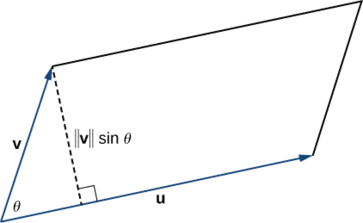
We show that the magnitude of the cross product is equal to the base times height of the parallelogram.
\begin{align*} \text{Area of a parallelogram} &= \text{base} × \text{height} \\[4pt] &=‖\vecs u‖(‖\vecs v‖\sin θ) \\[4pt] &=‖\vecs u×\vecs v‖ \end{align*}
□
Let P=(1,0,0),Q=(0,1,0), and R=(0,0,1) be the vertices of a triangle (Figure \PageIndex{6}). Find its area.
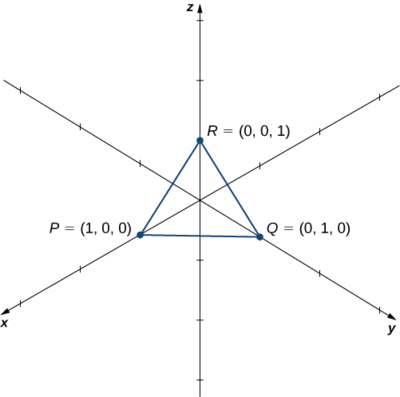
Solution
We have \vecd{PQ}=⟨0−1,1−0,0−0⟩=⟨−1,1,0⟩ and \vecd{PR}=⟨0−1,0−0,1−0⟩=⟨−1,0,1⟩. The area of the parallelogram with adjacent sides \vecd{PQ} and \vecd{PR} is given by ∥\vecd{PQ}×\vecd{PR}∥:
\begin{align*} \vecd{PQ} \times \vecd{PR} &= \begin{vmatrix}\mathbf{\hat i} & \mathbf{\hat j} & \mathbf{\hat k}\\−1 & 1 & 0\\−1 & 0 & 1\end{vmatrix} \\[4pt] &=(1−0)\mathbf{\hat i}−(−1−0)\mathbf{\hat j}+(0−(−1))\mathbf{\hat k} \\[4pt] &=\mathbf{\hat i}+\mathbf{\hat j}+\mathbf{\hat k} \\[10pt] ∥\vecd{PQ}×\vecd{PR}∥ &=∥⟨1,1,1⟩∥ \\[4pt] &=\sqrt{1^2+1^2+1^2} \\[4pt] &=\sqrt{3}. \end{align*} \nonumber
The area of ΔPQR is half the area of the parallelogram or \sqrt{3}/2 \, \text{units}^2.
Find the area of the parallelogram PQRS with vertices P(1,1,0), Q(7,1,0), R(9,4,2), and S(3,4,2).
- Hint
-
Sketch the parallelogram and identify two vectors that form adjacent sides of the parallelogram.
- Answer
-
6\sqrt{13}\, \text{units}^2
The Triple Scalar Product
Because the cross product of two vectors is a vector, it is possible to combine the dot product and the cross product. The dot product of a vector with the cross product of two other vectors is called the triple scalar product because the result is a scalar.
The triple scalar product of vectors \vecs u, \vecs v, and \vecs w is
\vecs u⋅( \vecs v× \vecs w). \nonumber
The triple scalar product of vectors
\vecs u=u_1 \mathbf{\hat i}+u_2 \mathbf{\hat j}+u_3\mathbf{\hat k} \nonumber
\vecs v=v_1\mathbf{\hat i}+v_2\mathbf{\hat j}+v_3\mathbf{\hat k} \nonumber
and
\vecs w=w_1 \mathbf{\hat i}+w_2\mathbf{\hat j}+w_3\mathbf{\hat k} \nonumber
is the determinant of the 3×3 matrix formed by the components of the vectors:
\vecs u⋅( \vecs v× \vecs w)=\begin{vmatrix}u_1 & u_2 & u_3\\v_1 & v_2 & v_3\\w_1 & w_2 & w_3\end{vmatrix}. \label{triple2}
The calculation is straightforward.
\begin{align*} \vecs u⋅( \vecs v× \vecs w) &=⟨u_1,u_2,u_3⟩⋅⟨v_2w_3−v_3w_2,−v_1w_3+v_3w_1,v_1w_2−v_2w_1⟩\\[4pt] &=u_1(v_2w_3−v_3w_2)+u_2(−v_1w_3+v_3w_1)+u_3(v_1w_2−v_2w_1) \\[4pt] &=u_1(v_2w_3−v_3w_2)−u_2(v_1w_3−v_3w_1)+u_3(v_1w_2−v_2w_1) \\[4pt] &=\begin{vmatrix}u_1 & u_2 & u_3\\v_1 & v_2 & v_3\\w_1 & w_2 & w_3\end{vmatrix}.\end{align*} \nonumber
□
Let \vecs u=⟨1,3,5⟩,\,\vecs v=⟨2,−1,0⟩ and \vecs w=⟨−3,0,−1⟩. Calculate the triple scalar product \vecs u⋅(\vecs v×\vecs w).
Solution
Apply Equation \ref{triple2} directly:
\begin{align*} \vecs u⋅(\vecs v×\vecs w) &=\begin{vmatrix}1 & 3 & 5\\2 & −1 & 0\\−3 & 0 & −1\end{vmatrix} \\[4pt] &=1\begin{vmatrix}−1 & 0\\0 & −1\end{vmatrix}−3\begin{vmatrix}2 & 0\\−3 & −1\end{vmatrix}+5\begin{vmatrix}2 & −1\\−3 & 0\end{vmatrix} \\[4pt] &=(1−0)−3(−2−0)+5(0−3) \\[4pt] &=1+6−15=−8. \end{align*} \nonumber
Calculate the triple scalar product \vecs a⋅(\vecs b×\vecs c), where \vecs a=⟨2,−4,1⟩, \vecs b=⟨0,3,−1⟩, and \vecs c=⟨5,−3,3⟩.
- Hint
-
Place the vectors as the rows of a 3×3 matrix, then calculate the determinant.
- Answer
-
17
When we create a matrix from three vectors, we must be careful about the order in which we list the vectors. If we list them in a matrix in one order and then rearrange the rows, the absolute value of the determinant remains unchanged. However, each time two rows switch places, the determinant changes sign:
\begin{vmatrix}a_1 & a_2 & a_3\\b_1 & b_2 & b_3\\c_1 & c_2 & c_3\end{vmatrix}=d \quad\quad \begin{vmatrix}b_1 & b_2 & b_3\\a_1 & a_2 & a_3\\c_1 & c_2 & c_3\end{vmatrix}=−d \quad\quad \begin{vmatrix}b_1 & b_2 & b_3\\c_1 & c_2 & c_3\\a_1 & a_2 & a_3\end{vmatrix}=d \quad\quad \begin{vmatrix}c_1 & c_2 & c_3\\b_1 & b_2 & b_3\\a_1 & a_2 & a_3\end{vmatrix}=−d
Verifying this fact is straightforward, but rather messy. Let’s take a look at this with an example:
\begin{align*} \begin{vmatrix}1 & 2 & 1\\−2 & 0 & 3\\4 & 1 & −1\end{vmatrix} &=\begin{vmatrix}0 & 3\\1 & −1\end{vmatrix}−2\begin{vmatrix}−2 & 3\\4 & −1\end{vmatrix}+\begin{vmatrix}−2 & 0\\4 & 1\end{vmatrix} \\[4pt] &=(0−3)−2(2−12)+(−2−0) \\[4pt] &=−3+20−2=15. \end{align*} \nonumber
Switching the top two rows we have
\begin{align*} \begin{vmatrix}−2 & 0 & 3\\1 & 2 & 1\\4 & 1 & −1\end{vmatrix} &=-2\begin{vmatrix}2 & 1\\1 & −1\end{vmatrix}+3\begin{vmatrix}1 & 2\\4 & 1\end{vmatrix} \\[4pt] &=−2(−2−1)+3(1−8)\\[4pt] &=6−21=−15. \end{align*} \nonumber
Rearranging vectors in the triple products is equivalent to reordering the rows in the matrix of the determinant. Let \vecs u=u_1\mathbf{\hat i}+u_2\mathbf{\hat j}+u_3\mathbf{\hat k}, \vecs v=v_1\mathbf{\hat i}+v_2\mathbf{\hat j}+v_3\mathbf{\hat k}, and \vecs w=w_1\mathbf{\hat i}+w_2\mathbf{\hat j}+w_3\mathbf{\hat k}. Applying Calculating a Triple Scalar Product, we have
\vecs u⋅(\vecs v×\vecs w)=\begin{vmatrix}u_1 & u_2 & u_3\\v_1 & v_2 & v_3\\w_1 & w_2 & w_3\end{vmatrix} \nonumber
and
\vecs u⋅(\vecs w×\vecs v)=\begin{vmatrix}u_1 & u_2 & u_3\\w_1 & w_2 & w_3\\v_1 & v_2 & v_3\end{vmatrix}. \nonumber
We can obtain the determinant for calculating \vecs u⋅(\vecs w×\vecs v) by switching the bottom two rows of \vecs u⋅(\vecs v×\vecs w). Therefore, \vecs u⋅(\vecs v×\vecs w)=−\vecs u⋅(\vecs w×\vecs v).
Following this reasoning and exploring the different ways we can interchange variables in the triple scalar product lead to the following identities:
\begin{align} \vecs u⋅(\vecs v×\vecs w)&=−\vecs u⋅(\vecs w×\vecs v)\\[10pt] \vecs u⋅(\vecs v×\vecs w)&=\vecs v⋅(\vecs w×\vecs u)=\vecs w⋅(\vecs u×\vecs v).\end{align} \nonumber
Let \vecs u and \vecs v be two vectors in standard position. If \vecs u and \vecs v are not scalar multiples of each other, then these vectors form adjacent sides of a parallelogram. We saw in Area of a Parallelogram that the area of this parallelogram is ‖\vecs u×\vecs v‖. Now suppose we add a third vector \vecs w that does not lie in the same plane as \vecs u and \vecs v but still shares the same initial point. Then these vectors form three edges of a parallelepiped, a three-dimensional prism with six faces that are each parallelograms, as shown in Figure \PageIndex{7}. The volume of this prism is the product of the figure’s height and the area of its base. The triple scalar product of \vecs u,\vecs v, and \vecs w provides a simple method for calculating the volume of the parallelepiped defined by these vectors.
The volume of a parallelepiped with adjacent edges given by the vectors \vecs u,\vecs v, and \vecs w is the absolute value of the triple scalar product (Figure \PageIndex{7}):
V=|\vecs u⋅(\vecs v×\vecs w)|. \nonumber
Note that, as the name indicates, the triple scalar product produces a scalar. The volume formula just presented uses the absolute value of a scalar quantity.
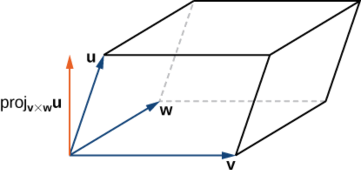
The area of the base of the parallelepiped is given by ‖\vecs v×\vecs w‖. The height of the figure is given by \|\text{proj}_{\vecs v×\vecs w}\vecs u\|. The volume of the parallelepiped is the product of the height and the area of the base, so we have
\begin{align*} V &=∥\text{proj}_{\vecs v×\vecs w}\vecs u∥‖\vecs v×\vecs w‖ \\[4pt] &=\left|\dfrac{\vecs u⋅(\vecs v×\vecs w)}{‖\vecs v×\vecs w‖}\right|‖\vecs v×\vecs w‖ \\[4pt] &=|\vecs u⋅(\vecs v×\vecs w)|. \end{align*}
□
Let \vecs u=⟨−1,−2,1⟩,\vecs v=⟨4,3,2⟩, and \vecs w=⟨0,−5,−2⟩. Find the volume of the parallelepiped with adjacent edges \vecs u,\vecs v, and \vecs w (Figure \PageIndex{8}).
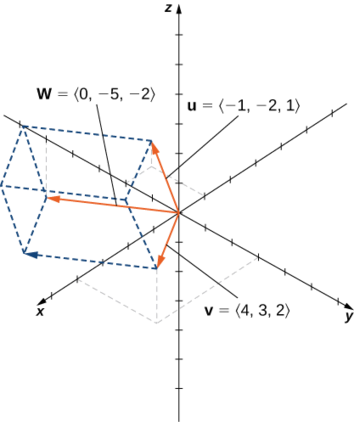
Solution
We have
\begin{align*} \vecs u⋅(\vecs v×\vecs w) &=\begin{vmatrix}−1 & −2 & 1\\4 & 3 & 2\\0 & −5 & −2\end{vmatrix} \\[4pt] &= (−1)\begin{vmatrix}3 & 2\\−5 & −2\end{vmatrix}+2\begin{vmatrix}4 & 2\\0 & −2\end{vmatrix}+\begin{vmatrix}4 & 3\\0 & −5\end{vmatrix} \\[4pt] &=(−1)(−6+10)+2(−8−0)+(−20−0) \\[4pt] &=−4−16−20 \\[4pt] &=−40.\end{align*}
Thus, the volume of the parallelepiped is |−40|=40 units3
Find the volume of the parallelepiped formed by the vectors \vecs a=3\mathbf{\hat i}+4\mathbf{\hat j}−\mathbf{\hat k}, \vecs b=2\mathbf{\hat i}−\mathbf{\hat j}−\mathbf{\hat k}, and \vecs c=3\mathbf{\hat j}+\mathbf{\hat k}.
- Hint
-
Calculate the triple scalar product by finding a determinant.
- Answer
-
8 units3
Applications of the Cross Product
The cross product appears in many practical applications in mathematics, physics, and engineering. Let’s examine some of these applications here, including the idea of torque, with which we began this section. Other applications show up in later chapters, particularly in our study of vector fields such as gravitational and electromagnetic fields (Introduction to Vector Calculus).
Use the triple scalar product to show that vectors \vecs u=⟨2,0,5⟩,\vecs v=⟨2,2,4⟩, and \vecs w=⟨1,−1,3⟩ are coplanar—that is, show that these vectors lie in the same plane.
Solution
Start by calculating the triple scalar product to find the volume of the parallelepiped defined by \vecs u,\vecs v, and \vecs w:
\begin{align*} \vecs u⋅(\vecs v×\vecs w)&=\begin{vmatrix}2 & 0 & 5\\2 & 2 & 4\\1 & −1 & 3\end{vmatrix} \\[4pt] &=[2(2)(3)+(0)(4)(1)+5(2)(−1)]−[5(2)(1)+(2)(4)(−1)+(0)(2)(3)] \\[4pt] &=2−2 =0. \end{align*}
The volume of the parallelepiped is 0 units3, so one of the dimensions must be zero. Therefore, the three vectors all lie in the same plane.
Are the vectors \vecs a=\mathbf{\hat i}+\mathbf{\hat j}−\mathbf{\hat k}, \vecs b=\mathbf{\hat i}−\mathbf{\hat j}+\mathbf{\hat k}, and \vecs c=\mathbf{\hat i}+\mathbf{\hat j}+\mathbf{\hat k} coplanar?
- Hint
-
Calculate the triple scalar product.
- Answer
-
No, the triple scalar product is −4≠0, so the three vectors form the adjacent edges of a parallelepiped. They are not coplanar.
Only a single plane can pass through any set of three noncolinear points. Find a vector orthogonal to the plane containing points P=(9,−3,−2),Q=(1,3,0), and R=(−2,5,0).
Solution
The plane must contain vectors \vecd{PQ} and \vecd{QR}:
\vecd{PQ}=⟨1−9,3−(−3),0−(−2)⟩=⟨−8,6,2⟩
\vecd{QR}=⟨−2−1,5−3,0−0⟩=⟨−3,2,0⟩.
The cross product \vecd{PQ}×\vecd{QR} produces a vector orthogonal to both \vecd{PQ} and \vecd{QR}. Therefore, the cross product is orthogonal to the plane that contains these two vectors:
\begin{align*} \vecd{PQ}×\vecd{QR} &= \begin{vmatrix}\mathbf{\hat i} & \mathbf{\hat j} & \mathbf{\hat k}\\−8 & 6 & 2\\−3 & 2 & 0\end{vmatrix}\\[4pt] &=0\mathbf{\hat i}−6\mathbf{\hat j}−16\mathbf{\hat k}−(−18\mathbf{\hat k}+4\mathbf{\hat i}+0\mathbf{\hat j})\\[4pt] &=−4\mathbf{\hat i}−6\mathbf{\hat j}+2\mathbf{\hat k}. \end{align*}
We have seen how to use the triple scalar product and how to find a vector orthogonal to a plane. Now we apply the cross product to real-world situations.
Sometimes a force causes an object to rotate. For example, turning a screwdriver or a wrench creates this kind of rotational effect, called torque.
Torque, \vecs \tau (the Greek letter tau), measures the tendency of a force to produce rotation about an axis of rotation. Let \vecs r be a vector with an initial point located on the axis of rotation and with a terminal point located at the point where the force is applied, and let vector \vecs F represent the force. Then torque is equal to the cross product of \vecs r and \vecs F:
\vecs \tau=\vecs r×\vecs F. \nonumber
See Figure \PageIndex{9}.
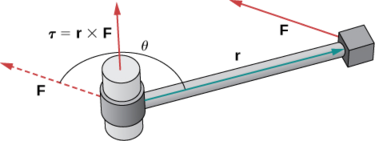
Think about using a wrench to tighten a bolt. The torque τ applied to the bolt depends on how hard we push the wrench (force) and how far up the handle we apply the force (distance). The torque increases with a greater force on the wrench at a greater distance from the bolt. Common units of torque are the newton-meter or foot-pound. Although torque is dimensionally equivalent to work (it has the same units), the two concepts are distinct. Torque is used specifically in the context of rotation, whereas work typically involves motion along a line.
A bolt is tightened by applying a force of 6 N to a 0.15-m wrench (Figure \PageIndex{10}). The angle between the wrench and the force vector is 40°. Find the magnitude of the torque about the center of the bolt. Round the answer to two decimal places.
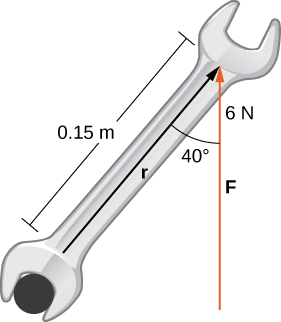
Solution:
Substitute the given information into the equation defining torque:
\begin{align*} ‖\vecs τ‖ &=\|\vecs r×\vecs F\| \\[4pt] &=‖\vecs r‖∥\vecs F∥\sinθ \\[4pt] &=(0.15\,\text{m})(6\,\text{N})\sin 40° \\[4pt] &≈0.58\,\text{N⋅m.} \end{align*}
Calculate the force required to produce 15 N⋅m torque at an angle of 30º from a 150-cm rod.
- Hint
-
‖\vecs τ‖=15 N⋅m and ‖\vecs r‖=1.5 m
- Answer
-
20 N
Key Concepts
- The cross product \vecs u×\vecs v of two vectors \vecs u=⟨u_1,u_2,u_3⟩ and \vecs v=⟨v_1,v_2,v_3⟩ is a vector orthogonal to both \vecs u and \vecs v. Its length is given by ‖\vecs u×\vecs v‖=‖\vecs u‖⋅‖\vecs v‖⋅\sin θ, where θ is the angle between \vecs u and \vecs v. Its direction is given by the right-hand rule.
- The algebraic formula for calculating the cross product of two vectors,
\vecs u=⟨u_1,u_2,u_3⟩ and \vecs v=⟨v_1,v_2,v_3⟩, is
\vecs u×\vecs v=(u_2v_3−u_3v_2)\mathbf{\hat i}−(u_1v_3−u_3v_1)\mathbf{\hat j}+(u_1v_2−u_2v_1)\mathbf{\hat k}.
- The cross product satisfies the following properties for vectors \vecs u,\vecs v, and \vecs w, and scalar c:
\vecs u×\vecs v=−(\vecs v×\vecs u)
\vecs u×(\vecs v+\vecs w)=\vecs u×\vecs v+\vecs u×\vecs w
c(\vecs u×\vecs v)=(c\vecs u)×\vecs v=\vecs u×(c\vecs v)
\vecs u×\vecs 0=\vecs 0×\vecs u=\vecs 0
\vecs v×\vecs v=\vecs 0
\vecs u⋅(\vecs v×\vecs w)=(\vecs u×\vecs v)⋅\vecs w
- The cross product of vectors \vecs u=⟨u_1,u_2,u_3⟩ and \vecs v=⟨v_1,v_2,v_3⟩ is the determinant \begin{vmatrix}\mathbf{\hat i} & \mathbf{\hat j} & \mathbf{\hat k}\\u_1 & u_2 & u_3\\v_1 & v_2 & v_3\end{vmatrix}
- If vectors \vecs u and \vecs v form adjacent sides of a parallelogram, then the area of the parallelogram is given by \|\vecs u×\vecs v\|.
- The triple scalar product of vectors \vecs u, \vecs v, and \vecs w is \vecs u⋅(\vecs v×\vecs w).
- The volume of a parallelepiped with adjacent edges given by vectors \vecs u,\vecs v, and \vecs w is V=|\vecs u⋅(\vecs v×\vecs w)|.
- If the triple scalar product of vectors \vecs u,\vecs v, and \vecs w is zero, then the vectors are coplanar. The converse is also true: If the vectors are coplanar, then their triple scalar product is zero.
- The cross product can be used to identify a vector orthogonal to two given vectors or to a plane.
- Torque \vecs τ measures the tendency of a force to produce rotation about an axis of rotation. If force \vecs F is acting at a distance (displacement) \vecs r from the axis, then torque is equal to the cross product of \vecs r and \vecs F: \vecs τ=\vecs r×\vecs F.
Key Equations
- The cross product of two vectors in terms of the unit vectors
\vecs u×\vecs v=(u_2v_3−u_3v_2)\mathbf{\hat i}−(u_1v_3−u_3v_1)\mathbf{\hat j}+(u_1v_2−u_2v_1)\mathbf{\hat k} \nonumber
Glossary
cross product
\vecs u×\vecs v=(u_2v_3−u_3v_2)\mathbf{\hat i}−(u_1v_3−u_3v_1)\mathbf{\hat j}+(u_1v_2−u_2v_1)\mathbf{\hat k}, where \vecs u=⟨u_1,u_2,u_3⟩ and \vecs v=⟨v_1,v_2,v_3⟩
determinant
a real number associated with a square matrix
parallelepiped
a three-dimensional prism with six faces that are parallelograms
torque
the effect of a force that causes an object to rotate
triple scalar product
the dot product of a vector with the cross product of two other vectors: \vecs u⋅(\vecs v×\vecs w)
vector product
the cross product of two vectors

